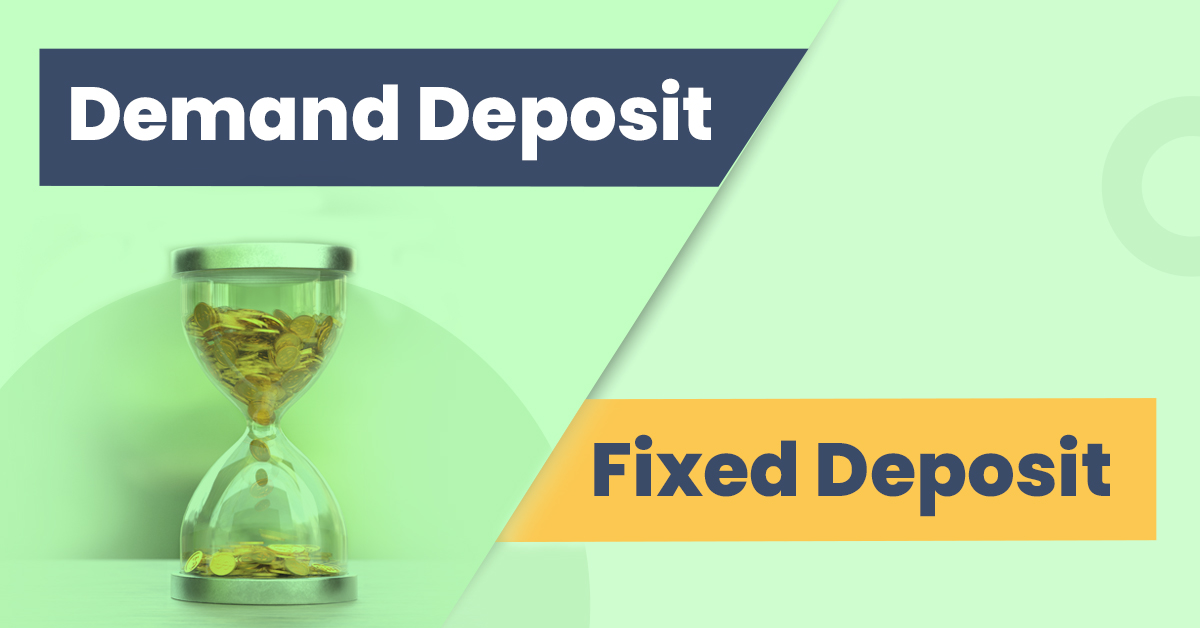Difference Between Demand and Fixed Deposits


India is a land of conservative investors. A recent SEBI survey shows that only 10% of Indians invest in equities, underlining our traditional approach. This is further evident in the amount of gold Indian households own.
Similarly, we also have an increased sense of trust when it comes to banks. That is why demand deposits and fixed deposits are often the top picks for conservative investors of all the investment schemes available in the financial market today.
Demand and fixed deposits are savings schemes offered by different financial institutions, especially banks. The main differences between demand deposits and fixed deposits lie in the degree of accessibility, earnings from the interest, and liquidity. Understanding both options in-depth will enable you to choose wisely.
Read on as we are about to dive deep and understand the differences clearly.
What is a Demand Deposit?
A demand deposit is a savings account from which you can withdraw your money on demand. In other words, the demand deposit permits you to withdraw funds freely at any given time. Because of this reason, the money deposited here equals ready cash or liquid money, similar to a savings account.
A demand deposit is a wise option to park your money as it generates interest income. While the interest is fixed and announced by the bank, they are subject to change, even during the investment tenure. However, such changes are rare and often don’t have a significant impact.
One feature that makes demand deposit an excellent option for conservative investors is its low-risk benefit and instant liquidity. Since there is no market linkage, your money remains secure from market volatility.
What is a Fixed Deposit?
A fixed deposit, also known as FD, is an investment option where you can invest a specified amount of money for a fixed amount of time. FDs are mainly offered by banks and Non-Banking Financial Institutions (NBFCs). FDs have become one of India’s most popular investment options due to people’s trust in banks.
FDs come with a fixed interest rate and maturity period. The fixed interest rate ensures that the income the investment generates remains fixed, making FDs a low-risk investment option.
In most cases, the interest generated by an FD is reinvested back into the corpus, and hence, the compounded corpus starts to generate interest. Further, you can withdraw the whole corpus at the end of the maturity period.
However, unlike the demand deposit, you will not be allowed to withdraw money before maturity. Even if prevailing circumstances necessitate premature withdrawals, a penalty will be levied.
Also Read: Experience financial growth with unmatched Bajaj Finance FD Rates
Differences Between Demand and Fixed deposit
The first significant difference between the two lies in the withdrawal procedures. You can access the demand deposit anytime sans any obligations, whereas FD can only be accessed after maturity. Moreover, you will have to pay penal charges if you withdraw the FD before maturity.
The interest rate for a demand deposit lies between 4 to 6%, depending on the bank you choose to put the money in. On the other hand, the interest rate on a fixed deposit can go up to 7 to 9%. In short, FDs tend to give you superior returns, but the obvious trade-off is the lock-in period and liquidity. While the fixed deposit has a fixed term, a demand deposit doesn’t.
Also Read: FD vs RD: Differences Between Fixed Deposits and Recurring Deposits
How do Demand and Fixed Deposit Accounts work?
There are generally two kinds of demand deposits that a bank provides. The first and the most popular is a savings account where you can park your money/savings without many obligations. Apart from a few withdrawal limitations, you can access the money anytime. You will also earn a fixed interest for the money you deposit.
The second type of demand deposit is a current account. This one is mainly used by people engaged in business and has higher minimum balance requirements compared to a savings account. In both cases, you can withdraw the money at any given point.
On the other hand, when it comes to fixed deposits, the money is deposited until a specific period, and the account is closed on maturity. Hence, FDs are a wise investment option for long-term deposits.
While premature FD withdrawals attract penalties, you can avail of credit cards or loans using your FD in case of urgent liquidity issues.
Concluding Thoughts
Demand and fixed deposits come with their share of merits and demerits; these are some of India’s most common and traditional investment options. Both work great for risk-averse investors looking to diversify their portfolios. From an investment perspective, however, fixed deposits appear more attractive as they offer a higher interest rate and better returns.
A robust savings portfolio will help you become financially secure in the future. Given that there are plenty of choices, the key lies in selecting an investment option that matches your investment horizon and risk appetite. Hence, ensure you do your research before choosing an investment option.
FAQs
What does a demand deposit account mean?
It is a bank account from which you can withdraw your deposited amount at any given time without any prior information. There are two main kinds of demand deposits – a savings account and a current account. A savings account is the more commonly used option here and gives you interest on the money you park. On the other hand, a current account is used by businesses and has higher minimum balance requirements.
Is it possible to have more than one demand and fixed deposit account in the same bank?
Yes, it is possible to have multiple fixed or demand deposits in the same or different banks as per your choice.
What are the disadvantages of demand deposits?
Some disadvantages of demand deposits include low-interest rates, high bank fees, and low capital appreciation.
What is the meaning of Flexi deposit?
It is a depository scheme offered predominantly by Indian banks, which includes demand and fixed deposits together. If you opt for a Flexi FD, you could avail yourself of the liquidity of savings, good returns, and current accounts.
How much money can I put in a fixed deposit?
It is a depository scheme offered predominantly by Indian banks, which includes demand and fixed deposits together. If you opt for a Flexi FD, you could avail yourself of the liquidity of savings, good returns, and current accounts.
What are the different types of demand deposits?
Financial institutions and banks broadly offer two main types of demand deposits:
> Current Account Deposit – operated chiefly by businesses.
> Savings Account Deposit – Suited for and used by individuals.
The main feature of every demand account is higher liquidity. But the interest rates are significantly lower compared to FDs.
How does the demand deposit work?
To make your demand deposit work, all you need to do is:
> Open a demand deposit in your bank.
> Deposit some money into the account.
> You can withdraw the amount as per your need whenever convenient.
Are fixed deposits transferable?
No, fixed deposits are non transferable. However, you may appoint a nominee to the account; in the case of your untimely demise, the funds will be transferred to the nominee.
What are the average interest rates for FD in India?
The interest rates and compounding of accrued but unpaid interest are specific features of FDs that differ from bank to bank. The average interest rate for FD ranges from 5 to 9%. Unlike your regular savings account, the income interest is substantial.



